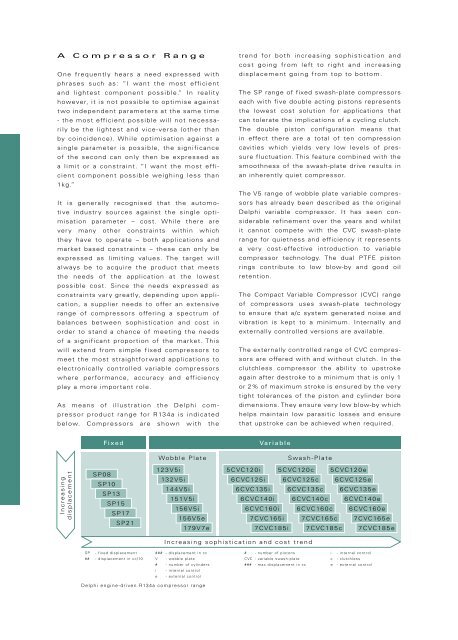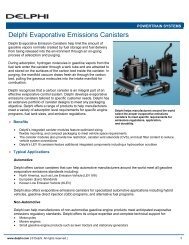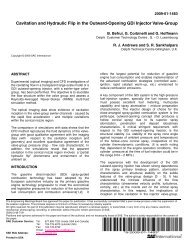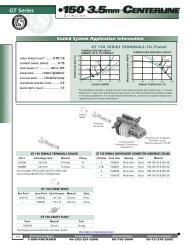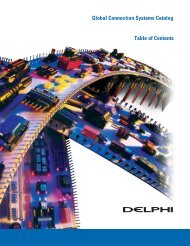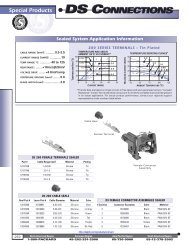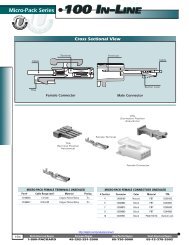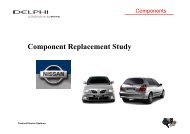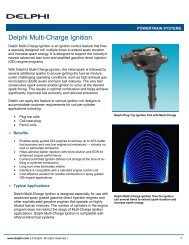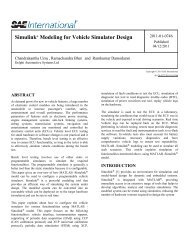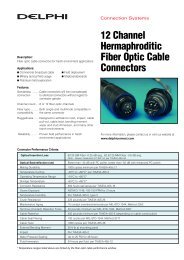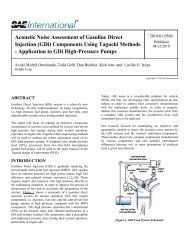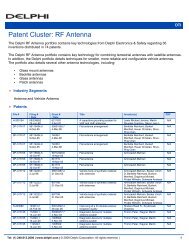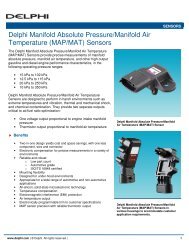Air Conditioning Compressors - Delphi
Air Conditioning Compressors - Delphi
Air Conditioning Compressors - Delphi
You also want an ePaper? Increase the reach of your titles
YUMPU automatically turns print PDFs into web optimized ePapers that Google loves.
A C o m p r e s s o r R a n g e<br />
One frequently hears a need expressed with<br />
phrases such as: ”I want the most efficient<br />
and lightest component possible.” In reality<br />
however, it is not possible to optimise against<br />
two independent parameters at the same time<br />
- the most efficient possible will not necessa-<br />
rily be the lightest and vice-versa (other than<br />
by coincidence). While optimisation against a<br />
single parameter is possible, the significance<br />
of the second can only then be expressed as<br />
a limit or a constraint. “I want the most effi-<br />
cient component possible weighing less than<br />
1kg.”<br />
It is generally recognised that the automo-<br />
tive industr y sources against the single opti-<br />
misation parameter – cost. While there are<br />
ver y many other constraints within which<br />
they have to operate – both applications and<br />
market based constraints – these can only be<br />
expressed as limiting values. The target will<br />
always be to acquire the product that meets<br />
the needs of the application at the lowest<br />
possible cost. Since the needs expressed as<br />
constraints var y greatly, depending upon appli-<br />
cation, a supplier needs to offer an extensive<br />
range of compressors offering a spectrum of<br />
balances between sophistication and cost in<br />
order to stand a chance of meeting the needs<br />
of a significant proportion of the market. This<br />
will extend from simple fixed compressors to<br />
meet the most straightfor ward applications to<br />
electronically controlled variable compressors<br />
where performance, accuracy and efficiency<br />
play a more important role.<br />
As means of illustration the <strong>Delphi</strong> com-<br />
pressor product range for R134a is indicated<br />
below. <strong>Compressors</strong> are shown with the<br />
I n c r e a s i n g<br />
d i s p l a c e m e n t<br />
S P 0 8<br />
F i x e d<br />
S P10<br />
S P13<br />
S P15<br />
S P17<br />
S P21<br />
SP - fixed displacement<br />
## - displacement in cc/10<br />
Wo b b l e Plate<br />
12 3 V 5 i<br />
13 2 V 5 i<br />
14 4 V 5i<br />
15 1 V 5i<br />
15 6V5i<br />
15 6V5e<br />
D e l p h i e n g i n e - d r i ve n R 13 4 a c o m p r e s s o r r a n g e<br />
trend for both increasing sophistication and<br />
cost going from left to right and increasing<br />
displacement going from top to bottom.<br />
The SP range of fixed swash-plate compressors<br />
each with five double acting pistons represents<br />
the lowest cost solution for applications that<br />
can tolerate the implications of a cycling clutch.<br />
The double piston configuration means that<br />
in effect there are a total of ten compression<br />
cavities which yields very low levels of pres-<br />
sure fluctuation. This feature combined with the<br />
smoothness of the swash-plate drive results in<br />
an inherently quiet compressor.<br />
The V5 range of wobble plate variable compres-<br />
sors has already been described as the original<br />
<strong>Delphi</strong> variable compressor. It has seen con-<br />
siderable refinement over the years and whilst<br />
it cannot compete with the CVC swash-plate<br />
range for quietness and efficiency it represents<br />
a very cost-effective introduction to variable<br />
compressor technology. The dual PTFE piston<br />
rings contribute to low blow-by and good oil<br />
retention.<br />
The Compact Variable Compressor (CVC) range<br />
of compressors uses swash-plate technology<br />
to ensure that a/c system generated noise and<br />
vibration is kept to a minimum. Internally and<br />
externally controlled versions are available.<br />
The externally controlled range of CVC compres-<br />
sors are offered with and without clutch. In the<br />
clutchless compressor the ability to upstroke<br />
again after destroke to a minimum that is only 1<br />
or 2% of maximum stroke is ensured by the very<br />
tight tolerances of the piston and cylinder bore<br />
dimensions. They ensure very low blow-by which<br />
helps maintain low parasitic losses and ensure<br />
that upstroke can be achieved when required.<br />
Variable<br />
Swash-Plate<br />
I n c r e a sing sophistication and cost trend<br />
### - displacement in cc<br />
V - wobble plate<br />
179V7e<br />
# - number of cylinders<br />
i - internal control<br />
e - external control<br />
5CVC120i<br />
6CVC125i<br />
6CVC135i<br />
6CVC140i<br />
6CVC160i<br />
7CVC165i<br />
7CVC185i<br />
# - number of pistons<br />
5CVC120c<br />
CVC - variable swash-plate<br />
6CVC125c<br />
6CVC135c<br />
### - max displacement in cc<br />
6CVC140c<br />
6CVC160c<br />
7CVC165c<br />
7CVC185c<br />
5CVC120e<br />
6CVC125e<br />
6CVC135e<br />
6CVC140e<br />
i - internal control<br />
c - clutchless<br />
6CVC160e<br />
7CVC165e<br />
e - external control<br />
7CVC185e


